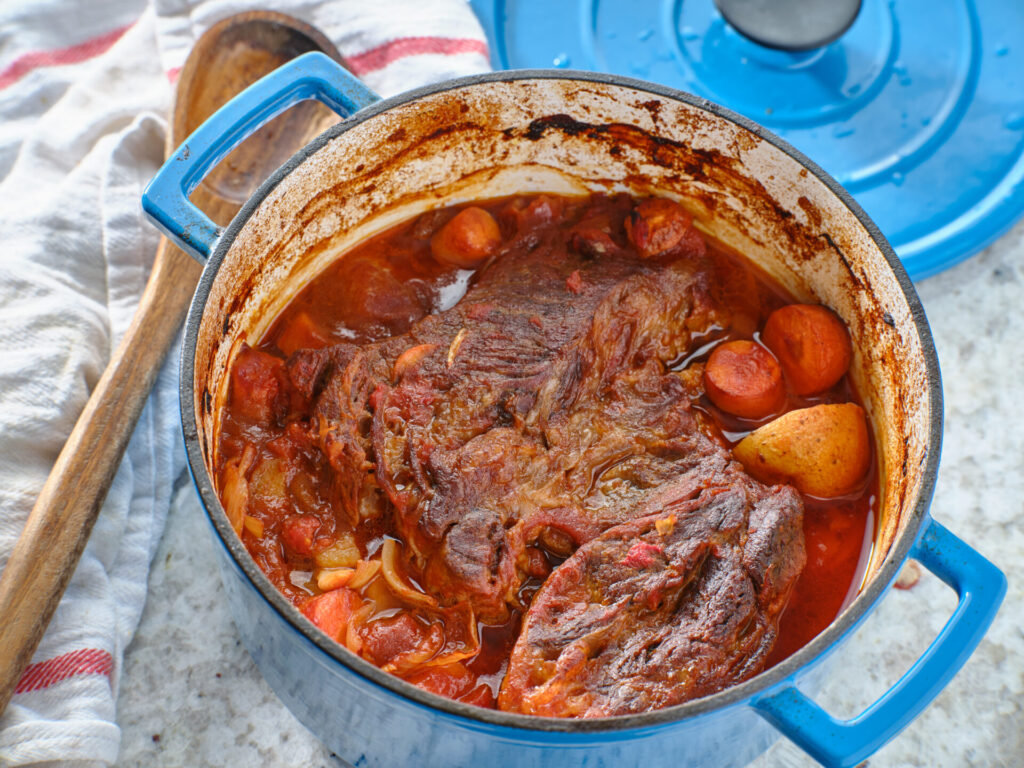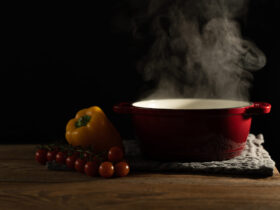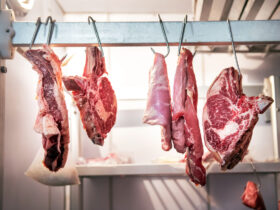Beef of good quality should not be too lean, but also not overly fatty. Generally, a fine and moderate marbling of beef is considered desirable. Marbling refers to the distribution of intramuscular fat within the meat, which is not located around the meat but rather interlaced between the individual muscle fibers.
Now, let’s take a closer look at the breakdown of the beef, including all the culinary important cuts and their uses.
You also should read the article about Meat Fundamentals to understand the basics about meat.
Cuts of beef for cooking / braising
Ideal for cooking and braising are the cuts of beef that have a slightly higher fat content, which helps them remain very tender and juicy. These cuts have a lot of connective tissue, which transforms into gelatin during the slow cooking process at lower temperatures.
Additionally, cuts with bones are very well suited for cooking and braising. The bones ensure more even heat distribution during the cooking process, which helps the meat cook more evenly. Bones contain moisture in the marrow, which keeps the meat juicy during cooking and adds additional flavor to the dish.

Most of these cuts are also perfect for cooking sous vide at low temperatures.
Since the meat of an animal cannot be strictly divided according to its use, some of these cuts can be used not only for cooking or braising but are much more versatile in their application.
Beef cheeks
Beef cheeks are an excellent choice for braising, as they contain a lot of connective tissue and collagen, which breaks down into gelatin during slow cooking, resulting in a tender texture and excellent flavor. Beef cheeks are also perfect for cooking sous vide. They need to be cooked at a low temperature for several hours to achieve the best results.
Neck, Nape
Since neck and nape meat is very affordable, it is often ground into minced meat or used for sausage making. Because this meat is marbled with fat and has many tendons, it can only be braised. It is particularly well-suited, for example, when cut into cubes for goulash.
Shoulder
Unlike the neck, the shoulder has a very low fat content. However, because the shoulder is still interlaced with many tendons and connective tissue, this cut is suitable only for braising and boiling. Part of the shoulder is called the “false fillet,” so named because it closely resembles beef fillet in appearance. This lean part of the shoulder, without tendons, can also be roasted or used for tartare.
Short Ribs
Short ribs are a moderately marbled cut of meat that can be divided into various layers. These include the lean top, the heavily marbled center with bones, and the middle section. Short ribs are particularly well-suited for soups, broths, and sauces, as the marbled meat and bones with marrow impart a lot of flavor.
Brisket
Brisket is divided into the point and the flat and is one of the tougher cuts of meat. However, through slow cooking or braising over several hours, brisket can become very tender and flavorful. Brisket is well-marbled with fat, which not only adds flavor but also moisture and tenderness during cooking.
Top Round, Round
Top round is interlaced with fine veins of fat, and the meat is very tender. This cut is very versatile and can be used for cooking, braising, roasting, and grilling.
Leg, Topside, Silverside, Round
The leg comprises the largest portion of beef and the cuts are very versatile. Some of the tenderest cuts come from the leg, and they can be both braised and roasted. The leg is divided into the topside, silverside, and round.
Shank
The shank and shin meat are very tendon-rich and require long, slow cooking at a low temperature. These cuts are mainly used for braising.
Tail
The tail of the cow contains a lot of connective tissue, collagen, and bones. Before cooking, the tail must be divided into individual segments. It is perfect for cooking or braising at a lower temperature over a longer period.
Cuts of beef for roasting / grilling / baking
Ideal for roasting or grilling are cuts of beef that have a lower fat content and less connective tissue and tendons. Therefore, these cuts can be cooked at higher temperatures.
Since the meat of an animal cannot be strictly divided according to its use, some of these cuts can be used not only for roasting or grilling but are much more versatile in their application.














Leave a Reply
View Comments